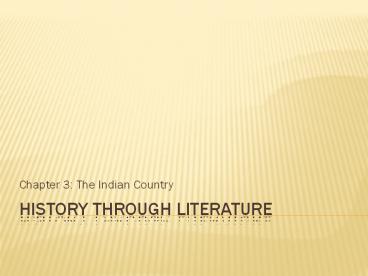History Through Literature - PowerPoint PPT Presentation
Title:
History Through Literature
Description:
Chapter 3: The Indian Country Turn to page 261 of our regular text book. Read the Setting the Scene paragraphs. Compare with Ambrose on page 28 and page 35 The Great ... – PowerPoint PPT presentation
Number of Views:134
Avg rating:3.0/5.0
Title: History Through Literature
1
History Through Literature
- Chapter 3 The Indian Country
2
The Indian Problem
- Turn to page 261 of our regular text book. Read
the Setting the Scene paragraphs. - Compare with Ambrose on page 28 and page 35
- The Great West after Civil War was a 1,000 square
mile of nothing mountains, plateaus, deserts
and plains (Indians), 25 years later it was
carved into states never before in human
experience has so huge an area been transformed
so rapidly. - Oklahoma
3
The Plains Indians
- Live in the Great Plains
- Used buffalo
- Were agriculture but with the introduction of the
horse, became nomadic again. - Nomadic Indians increased warriors increased
warfare - Fought among themselves as much as against
settlers.
4
The US Government
- No settlers from Mississippi to California
- US make land more productive
- Restricted Native Americans to reservations
- used chiefs who were not really cheifs
- Did not honor treaties
- BIA poor job delivering supplies to
Indians/lots of corruption
5
George Armstrong Custer
- 1939-1876
- General in Civil War and Indian Wars
- Vain, heedless of authority and foolhardy
- Achieved great distinction in the Civil War
- Chief of Thieves
- Court Marshaled twice
- Killed at Little Big Horn
6
Crazy Horse
- Lakota Sioux
- Believed he had visions
- Born natural leader
- Brains behind the Fetterman Massacre tricked US
army - Might have led flanking assualt that doomed
Custer at Little Big Horn.
7
Battles
- Most Indians died from disease not bullets
- No alliances among Indians
- Sand Creek Massacre, 1864 after some Cheyenne
raids on wagon trains. - Chief Black Kettle (had nothing to do with raids)
was lured to a peace meeting at Sand Creek US
slaughtered 150 500 men, women and children - Fetterman Massacre US Captain and 81 men killed
an mutilated - Little Bighorn, 1876 Custer found gold in the
Black Hills, Red Cloud entered into agreements to
sell it. Sitting Bull and Crazy Horse refused,
met Custer with 2,000 Indians against his 200.
Custers Last Stand (originally attacked the
village) - Reports that Crazy Horse was restless, US
arrested him, he resisted and was shot. His
followers surrendered, but during the surrender,
someone fired a shot and 200 Sioux were killed.
8
History?
- When Whites wiped out Indians, the engagement was
usually a battle. - When Indians wiped out whites, it was a massacre.
- Strategy, when practiced by Indians was a
treachery.
9
Assimilation
- Tried to change Native American Culture.
- Sent to schools to be educated as Americans
- 1887 Dawes act outlawed concept of shared land
now private property - Land divided up into 160 acres and NA told to
farm by 1932 2/3 of Indian land in the hands of
Americans.
10
Conclusions
- History text book page 267
- Ambrose page 41
- Transcontinental railroad was a literal dagger
through the heart of Indian country. Bring
troops, supplies and settlers - Indians showed little resistance to disease and
no resistance to firewater.

